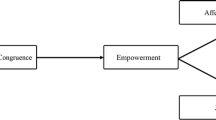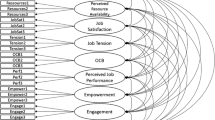Abstract
Part 1 of this exploratory study demonstrated that for terminal, instrumental, and work values, supervisors could only accurately assess the extent to which their terminal values are congruent with their employees, whereas, employees could only accurately describe degrees of alignment with their supervisors’ work values. Thus, supervisors appear to possess conscious awareness of the terminal values held by their employees and employees similarly possess conscious awareness of their supervisors’ work values. Part 2 of the study examined what each of these two parties might do with their conscious knowledge concerning value congruence with the other member. Supervisor ratings and employee self-ratings concerning employee job performance, citizenship, climate fit, working relationship (LMX), and other issues, were correlated with supervisor terminal value congruence estimates and employee work value congruence estimates respectively. For supervisors, only one significant finding was noted, indicating a positive relationship between the supervisors’ awareness of terminal value congruence with the employee and the supervisors’ estimate of the employee’s potential for future promotion. For employees, seven hypotheses received support demonstrating relationships between the employees’ 0awareness of supervisor/employee work value congruence and self-ratings of work behaviours, citizenship behaviours, volunteerism behaviours, work climate behaviours, work climate attitudes, work climate organizational-wide attitudes, and the supervisor/employee working relationship. Implications for management and future research are discussed.
Similar content being viewed by others
References
C. L. Adkins E. C. Ravlin B. M. Meglino (1996) ArticleTitle‘Value Congruence Between Co-workers and its Relationships to Work Outcomes’ Group and Organizational Management 21 IssueID4 439–460
M. Alvesson (1987) ArticleTitle‘Organizations, Culture and Ideology’ International Studies of Management and Organization 17 IssueID3 4–18
Y. Apasu (1987) ArticleTitle‘The Importance of Value Structures in the Perception of Rewards by Industry Salespersons’ Academy of Marketing Science 15 IssueID1 1–10
R. W. Beatty C. E. Schneier (1977) Personnel Administration: An Experimental Building Approach Addison Wesley Reading, MA
A. P. Brief S. J. Motowidlo (1986) ArticleTitle‘Prosocial Organizational Behaviors’ Academy of Management Review 11 IssueID4 710–725
H. J. Brightman L. Sayeed (1990) ArticleTitle‘The Pervasiveness of Senior Management’s View of the Culture Gaps within a Division’ Groups and Organizational Studies 15 IssueID3 266–278
Brown, T. L.: 1987, When Values Collide, World Executive’s Digest (May), 29--35.
J. Browne (2002) ArticleTitle‘Validation of the Healthy Work Organizations Model’ Journal of American Academy of Business 1 IssueID2 206–214
C. H. Campbell P. Ford M. G. Rumsey E. D. Pulakos W. C. Borman D. B. Felker M. V. DeVera B. J. Rigelhaust (1990) ArticleTitle‘Development of Multiple Job Performance Measures in a Representative Sample of Jobs’ Personnel Psychology 43 IssueID2 277–292
J. Cashman F. Dansereau G. Graen W. J. Haga (1976) ArticleTitle‘Organizational Understructure and Leadership: A Longitudinal Investigation of the Managerial Role-making Process’ Organizational Behavior and Human Performance 15 278–296
J. Chyna (2002) ArticleTitle‘Is Your Culture E-compatible?’ Healthcare Executive 17 IssueID1 53–54
Corbett, W.: 1986, ‘The Communication Tools Inherent in Corporate Cultures’, Personnel Journal (April), 71--74.
Dansereau, F., J. Cashman and G. Graen: 1973, ‘Instrumentality Theory and Equity Theory as Complementary Approaches in Predicting the Relationship of Leadership and Turnover Among Managers’, Organizational Behavior and Human Performance (October), 184--200.
T. E. Deal A. A. Kennedy (1982) Corporate Cultures: The Rites and Rituals of Corporate Life Addison-Wesley Reading, Massachusetts
N. M. Dixon (2000) Common Knowledge: How Companies Thrive by Sharing What They Know Harvard Business School Press Boston MA
J. J. Dose (1997) ArticleTitle‘Work Values: An Integrative Framework and Illustrative Application to Organizational Socialization’ Journal of Occupational and Organizational Psychology 70 IssueID3 219–240
D. Duchon S. G. Green T. D. Taber (1986) ArticleTitle‘Vertical Dyad Linkage: A Longitudinal Assessment of Antecedents, Measures and Consequences’ Journal of Applied Psychology 71 51–60
N. T. Feather (1975) Values in Education and Society Free Press New York
R. T. Golembiewski (1979) Approaches to Planned Change, Part One: Orienting Perspectives and Micro-Level Interventions Marcel Dekker New York
Graen, G. and J. Cashman: 1975, ‘A Role-making Model of Leadership in Formal Organizations: A Developmental Approach’, in J. G. Hunt and L. L. Larson (eds.), Leadership Frontiers (Kent State University, Kent, OH).
G. Graen T. A. Scandura (1987) ArticleTitle‘Toward a Psychology of Didactic Organizing’ Research in Organizational Behaviour 9 175–208
J. B. Herman (1973) ArticleTitle‘Are Situational Contingencies Limiting Job Attitude – Job Performance Relationships?’ Organizational Behavior and Human Performance 10 208–224
R. G. Isaac A. R. Cahoon W. J. Zerbe (1992) ArticleTitle‘Values in Corporations – Who is in Charge?’ International Journal of Value-Based Management 5 IssueID2 93–104
L. R. James A. P. Jones (1974) ArticleTitle‘Organization Climate: A Review of Theory and Research’ Psychological Bulletin 81 1096–1112
G. Johns (1981) ArticleTitle‘Difference Score Measurements of Organizational Behavior Variables: A Critique’ Organizational Behavior and Human Performance 27 443–463
D. Katz (1964) ArticleTitle‘The Motivational Basis of Organizational Behavior’ Behavioral Science 9 131–146
A. S. King (1995) ArticleTitle‘Multiphase Progression of Organizational Ideology and Commitment’ The Mid-Atlantic Journal of Business 31 IssueID2 143–160
L. Larson (2002) ArticleTitle‘A New Attitude: Changing Organizational Culture’ Trustee 55 IssueID4 8–14
Liden, R. C. and G. Graen: 1980, ‘Generalizability of the Vertical Dyad Linkage Model of Leadership’, Academy of Management Journal (September), 451--465.
J. M. Liedtka (1989) ArticleTitle‘Value Congruence: The Interplay of Individual and Organizational Value Systems’ Journal of Business Ethics 8 805–815
Loveland, J. P. and J. L. Mendleson: 1974, ‘Employee Responsibility a Key Goal for Managers’, Human Resource Management (Spring), 32--36.
K. Ludeman (1991) ArticleTitle‘Managing Skills and Behaviors’ Training and Development 45 IssueID11 61–66
R. H. Moos (1986) Work Environment Scale Manual Consulting Psychologist’s Press Palo Alto, CA
M. Moravec (1996) ArticleTitle‘Bringing Performance Management Out of the Stone-age’ Management Review 85 IssueID4 38–40
Nord, W. R., A. P. Brief, J. M. Atieh and E. M. Doherty: 1990, ‘Studying Meanings of Work: The Case of Work Values’, in A. P. Brief and W. R. Nord (eds.), Meanings of Occupational Work (Lexington Books, Lexington Massachusetts).
J. C. Nunnaly (1967) Psychometric Theory McGraw-Hill New York, NY
J. C. Nunnaly (1978) Psychometric Theory McGraw-Hill New York, NY
D. Osborne P. Plastrik (2000) ArticleTitle‘Maximize on Cultural Shifts’ Government Executive 32 IssueID11 61–68
C. Ostroff (1993) ArticleTitle‘The Effects of Climate and Personal Influence on Individual Behavior and Attitudes in Organizations’ Organizational Behavior and Human Decision Processes 56 56–90
G. Pine G. Innis (1987) ArticleTitle‘Cultural and Individual Work Values’ Career Development Quarterly 35 IssueID4 279–287
Pitts, R. E. and K. Thompson: 1979, ‘The Supervisor’s Survival Guide: Using Job Behaviors to Measure Employee Performance’, Supervisory Management (January), 23--30.
B. Z. Posner (1992) ArticleTitle‘Person–organization Values Congruence: No Support for Individual Differences as a Moderating Influence’ Human Relations 45 IssueID4 351–361
H. J. Pratt (1991) ArticleTitle‘Principles of Effective Performance Management’ Records Management Quarterly 25 IssueID1 28–37
Robbins, S. P.: 1998, Organizational Behavior, 8th Edition (Prentice Hall, Upper Saddle River, NJ).
M. Rokeach (1967) Value Survey Halgren Tests Sunnyvale California
M. Rokeach (1973) The Nature of Human Values The Free Press New York, NY
T. Rollins M. Fruge (1992) ArticleTitle‘Performance Dimensions: Competencies with a Twist’ Training 29 IssueID1 47–51
Schein, E. H.: 1986, ‘Are You Corporate Cultured?’ Personnel Journal (November), 83–96.
R. W. Scholl (1983) ArticleTitle‘Career Lines and Employment Stability’ Academy of Management Journal 26 86–103
R. W. Scholl E. A. Cooper J. F. McKenna (1987) ArticleTitle‘Referent Selection in Determining Equity Perceptions: Differential Effects on Behavioral and Attitudinal Outcomes’ Personnel Psychology 40 113–124
L. Smircich (1983) ArticleTitle‘Concepts of Culture and Organizational Analysis’ Administrative Science Quarterly 28 339–358
S. M. Sommer S.-H. Bae F. Luthans (1996) ArticleTitle‘Organizational Commitment Across Cultures: The Impact of Antecedents on Korean Employees’ Human Relations 49 IssueID7 977–993
P. Toulson M. Smith (1994) ArticleTitle‘The Relationship Between Organizational Climate and Employee Perceptions of Personnel Management Practices’ Public Personnel Management 23 IssueID2 453–468
Author information
Authors and Affiliations
Corresponding author
Rights and permissions
About this article
Cite this article
Isaac, R.G., Kim wilson, L. & Pitt, D.C. Value Congruence Awareness: Part 2. DNA Testing Sheds Light on Functionalism. J Bus Ethics 54, 303–315 (2004). https://doi.org/10.1007/s10551-004-1169-6
Issue Date:
DOI: https://doi.org/10.1007/s10551-004-1169-6




